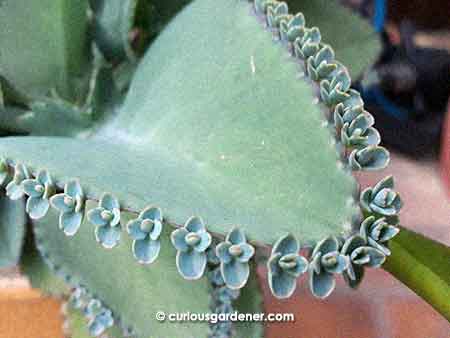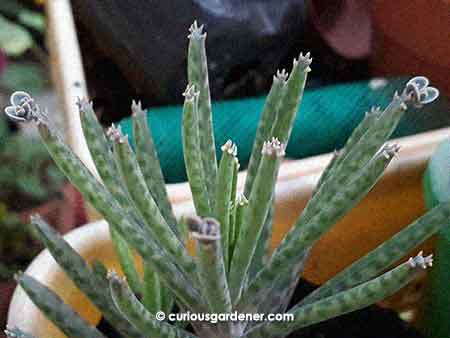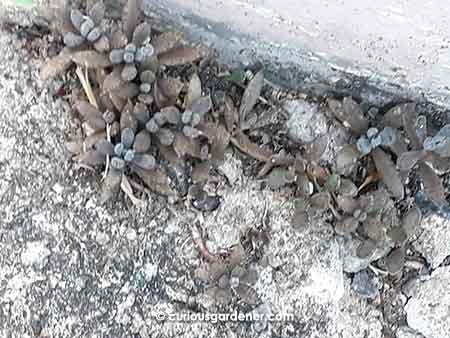
Mother of Thousands – an apt name! Just look at all those baby plants waiting to drop and start growing…
I’m familiar with the kalanchoe plant – it has roundish, succulent leaves and has the most interesting habit of reproducing by growing new baby plants along the edges of the leaves, which drop off and quickly take root. This has given rise to its colloquial name, Mother of Thousands – which I honestly believe it can live up to.
Well, a friend recently asked if I could harvest some kalanchoe that she had heard about, growing wild somewhere in my regular stomping grounds. It was a different type of kalanchoe, she said, with skinny leaves but with the same habit of reproducing. Armed with an address and a photo of the plant, I went on the hunt.
I missed the plants on my first pass because they were pretty small – only about 7cm high (less than 3 inches) for the biggest of them. They were young plants, and the few that were growing were doing so in cracks in the cement, for the most part.
My preparation for this hunt was simple – I had a ziplock bag, a bottle of water, and tissue paper. Before harvesting anything, I first dampened the tissue paper and laid it along the bottom of the ziplock bag. Only then did I gently harvest some baby plants growing at the tips of each leaf. Since the plants were small, there were only about three babies per leaf. I scattered them onto the damp tissue then considered whether or not to harvest any plants.
Gently holding the base of one of the smaller plants, I lifted it to see how much, if any, of the root system would come along. About a centimetre of main root came up, with a tiny bit of secondary root. It didn’t look like much, but I enclosed the tiny roots in the damp tissue before lifting a second small plant, just to be kiasu. I chose young plants because I reckoned small plants would recover faster from any transplant shock.
Since I was transferring the plants from blazing heat into a damp, humid environment, I tried to make sure the leaves of the plants touched the wet tissue as little as possible. With that done, I sealed up the ziplock bag, trying to keep a lot of air inside so that the plants would be cushioned as I was went about. In a way, it was a sort of makeshift terrarium – that thankfully worked.
On my return home, I placed the two adult plants in some potting mix, and left the babies enclosed in the ziplock bag. Would you believe it – by the next day, the babies were all putting out roots! Yup, this is indeed a hardy plant. Just consider – they were growing in hard, compacted soil and in cracks in cement. I wonder if the plants will become a nuisance given a little more time? Knowing the characteristics of the kalanchoe plant, probably yes…
To get more familiar with this new(ish) plant, I went online to try to find out more about it. I think it’s the kalanchoe tubiflora, but I was shocked to learn that kalanchoe are poisonous plants. If consumed, they can affect the electrolyte balance in the heart muscle of both humans and animals (not that I have any inclination to eat them). One case that was mentioned a few times comes from Australia where a herd of cows died after grazing on these plants. You can read a bit more about the possible dangers from this plant at this website. I wonder if this means that snails don’t have hearts, because we had one regular kalanchoe plant that had been under constant attack by snails, and we didn’t see any dead snails around..

The kalanchoe tubiflora leaves looks uncannily like reptilian paws to me, reaching upwards. Each leaf tip bears about 3 babies.
There’s no doubt that many plants that we grow are partly poisonous, and while it’s highly unlikely that we’ll suddenly decide to eat them for no apparent reason, it’s good to know which ones to be cautious about.
© 2018 curiousgardener.com All rights reserved.

